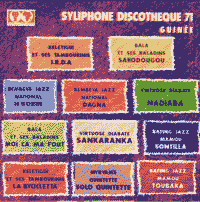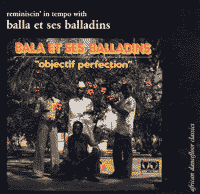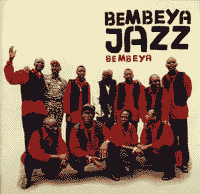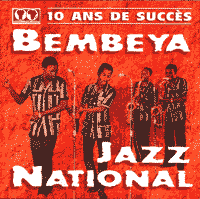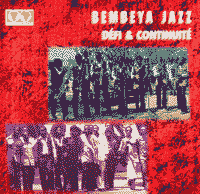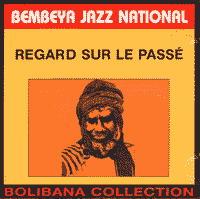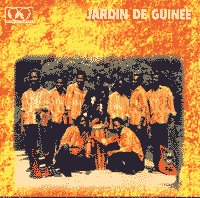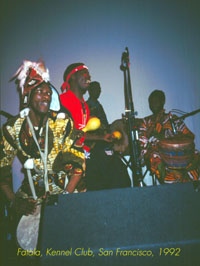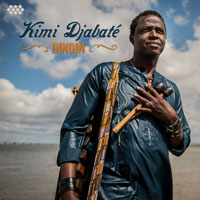
KIMI DJABATE
DINDIN (Cumbancha)
A very polished album, this is the fourth outing from Kimi Djabaté. Many generations ago, his ancestors from Mali went to Guinea-Bissau to perform at court, were invited to stay in Tabato and they turned the area into a cultural center for music, dance, arts and crafts. To me, Dindin is a childhood expression for dinner, and curiously the title track is about hungry children. Don't exploit them, educate them, but leave them time for playing games, he enjoins. He himself was forced into a musical career, against his will, and made to practice balafon rather than study schoolwork, and often went hungry. At 8 he was sent to another village to study kora. He was a child performer, but took no joy in it. At 19 he joined the national dance troupe and jumped ship in Lisbon, deciding to settle there, rather than return home. He has been in Portugal for 30 years now, broadening his musical horizons. Justice and hope are his main themes. The ballad, "Ná (Mother)," reminds me of Touré Kunda, and once I made that connection (specifically to the album Casamance au Clair de Lune), I began to feel strong parallels with those other griots. The album is generally contemplative. There are sweet touches of balafon and then we hear electric guitar and surprisingly Paolo Borges, an accordionist, joins in. Kimi was featured on Madonna's latest hit "Ciao Bella" but fortunately he did not invite her to reciprocate. "Afonhe" has Borges playing a reggae organ riff, with pumped up horns. "Alidonike" features wild Toureg-style lead guitar and more of a Malian rock groove with balafon continuo. I presume Djabaté is multi-tracked on this one. Overall, this is an accomplished and mellow album.
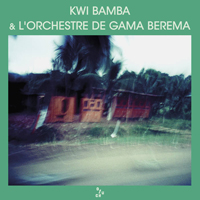
KWI BAMBA
KWI BAMBA & L'ORCHESTRE DEGAMA BEREMA (Ouch! Records)
The Guinean state-sponsored band Nimba Jazz, later Le Nimba de N'zerekore, is one of those fabled bands of the post-Independence era of the 1960s. Their 1980 album Gön Bia Bia (SLP71) is a gem, but if you have only heard the Syllart CD you are missing the clarity and sharpness of the horns and percussion. Many people, including bloggers Stefan Werdekker and John Beadle, have commented on how Sylla distorted the Syliphone albums when he got his hands on the rights to reissue them (in dubious circumstances), losing definition when he tweaked them in remastering. The maestro Kwi Bamba was leader of those bands and is still creating the same style of propulsive, relentlessly grooving music. This album, more a non-stop party, was recorded in the bush in 1999 by Frédéric Migeon. It is a live set of great intensity and joy, with bright speedy guitars and wild, sparkling reeds (soprano sax) over a panoply of crashing drums, including drum kit and I think I hear bottle percussion too. Given that it is a live recording I wouldn't be surprised. Once again I am indebted to our Washington bureau chief, Ken A, for turning me onto this wonderful set.
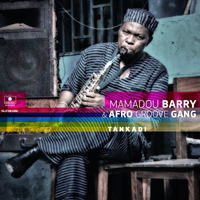
MAMADOU BARRY & AFRO GROOVE GANG
TANKADI (Label Bleu)
I put this on, and at first I thought this was gonna be yet another African funk thing with a popping bass and a highlife-down-low rhythm: it's very smooth and has strong jazz sax over the R&B bass and drums on the opening track "Saramaya." But then a more classic sounding Guinean groove enters and the vista expands. Barry paid his dues with Kaloum Star, which he founded in 1969, and then with Les Amazones and Bembeya Jazz before creating the Afro Groove Gang in 2009. There's a hopped-up cover of Coltrane's "Afro Blue" which another Guinean saxman, Momo "Wandel" Soumah also performed. Soumah's version with balafon accompaniment has the edge. On surer ground they rip out a new version of "Felenko" which was the title cut on the outstanding Kaloum Star album which came out in 1996 on Buda. The vocalist on here sounds like Momo Soumah, an odd coincidence? One Swiss (?) site says Mamadou inherited his mantle, which tells us that Momo is probably dead, and explains why Mamadou looks like he is wearing prison garb on the cover. Not really. I am being driven to distraction by a wonky samba track called "Café café." The bass keeps on a-poppin, to be sure we notice him. I have no idea who is on here, there's no info on line, Label Blue's website has no info and doesn't appear to be maintained. The title track is understated, and is very much in the Bembeya Jazz mode, featuring Mamadou on flute. The next cut "Soumbara" has a New York Latin pulse to it, and Mamadou on flute again, then sax. It catches fire with a great djembe drum solo to end. "Kankalabé" has a pleasant reggae groove, not a typical lame African Alpha Blondy one, as the album coasts along with a lot of ideas on display.
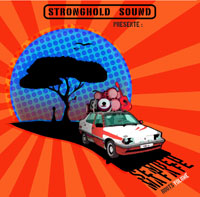
SEMBEH MA FA FE (ROOTS VOLUME) (Stronghold Sound)
Here's some tribal music from Guinea, some of it raw and ready, some of it remixed with dubby bass 'n' drums by the likes of Captain Planet, Chief Boima, J Boogie and Dub Snakkr. The scorching Captain Planet remix of "Tounkan" posted on soundcloud caught my ear and made me want to check out the rest of this. It's a traditional piece with djembe and balafon and a woman (Saran?) singing. The remix is looped with an overdubbed syn bass and drums, to give it more disco-oomph. (Though the vocals have not been treated.) Dub Snakkr, the man behind the label, has recently done some exploration of post-revolutionary Arabia (Arab HipHop in the Wake of Revolutions) and while he was on the continent he returned to Guinea looking for old and new artists for the label's first all-African release. The dozen traditional sides are great; the four remixes come halfway through and fit in nicely. I am no purist: I like to hear white rockers jamming with Africans (if they are good). I know the planet is shrinking but I manage to block out everything that bugs me about contemporary pop music (I just discovered Eminem is white! I still don't know his music and I am sure I don't want to: I should have guess his ethnicity from his name but I try not to notice. Wait, the Beastie Boys are white too? I really have got this hippety hoppity thing all wrong then.) Anyway the return to the traditional stuff is good because then you notice the ferocity of the balafon and drums (and djembes) and realize you don't really need the added dub stuff to enjoy this, it just makes a nice change and spices up the proceedings a bit.
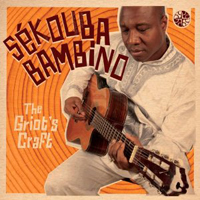
SEKOUBA BAMBINO
THE GRIOT'S CRAFT (Stern's STCD1117)
Sékouba "Bambino" Diabaté is one of the most accomplished musicians currently performing in Africa. His voice reminds me a bit of Salif Keita: it has that intense level of command and power, but that is also abetted by the big booming production which uses echo to amplify the studio space. He hails from Northeastern Guinea, near the Malian border and is a griot or "Jali" of the Mande people, meaning he has learned all the history songs and epic poems handed down for generations. When he was 19 his soaring vocals brought him to the attention of folks in the capital, Conakry, where he was invited to join Bembeya Jazz National. As most of the members of the National orchestra were already in their forties, the youngster was nicknamed "Bambino"-- Italian for baby -- and the name stuck. Just as well or you might confuse him with Sekou "Bembeya" Diabaté (aka Diamond Fingers), the lead guitarist of Bembeya Jazz. Bambino also sang on the third Africando album, and lived to tell the tale. On this outing he is backed by acoustic guitar, bass, calabash, and various traditional instruments including ngoni, kamele ngoni, kora, and balafon. I hear djembe also though it's not credited in the line-up. There's a big chorus of four women and by the third track, "Moya kankoun," they are in full call-&-response mode, with tasty electric guitar licks from Djessou Mory Kanté (no, not that Mory Kanté who sang with Rail Band). Bambino comes up to date with a song about the horror of female circumcision. Be glad you can't follow the lyrics on this one. We are so fortunate to be able to hear music of this calibre, beautifully performed and recorded, in the comfort of our own homes. This would not have been possible a century ago, yet the music is timeless and reaches across centuries to tell us of great warriors and kings who conquered the desert in the time of myths.
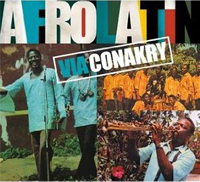
AFROLATIN VIA CONAKRY
I love Guinean music, particularly the Latin-flavoured stuff, but I didn't get this comp figuring I must have most of it. I certainly have all the Bembeya, Jardin de Guinee, Balladins and Keletigui material which is undoubtedly the best stuff on here. However the selectors have dug deep to find some obscurities here, like the first cut, Kebendo Jazz's "Woulignewa" (which sounds promising from the 30 second clip on amazon), Horoya Band's "Sabougnouma" (which sounds thrashed), Auberge's "Boum a Conakry," De la Paillote's "Yamalele," and others. But they may just be musical curios; it's hard to tell from internet samples. And while it is interesting to hear African bands covering Latin music, if you want to hear a real descarga you need to go to Fania All-Stars, Alegre All-Stars or a group like Jules Sagna's Orchestra Rytmo Africa-Cubana -- at that time few African bands were going for the ten-minute blow-out jam. I still haven't bought VIA CONAKRY, but will wait to see if it turns up used to satisfy my curiosity whether the unknown acts on here are up to snuff.
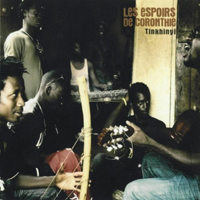
LES ESPOIRS DE CORONTHIE
TINKHINYL (Wounta 3105)

KELETIGUI ET SES TAMBOURINIS
THE SYLIPHONE YEARS (Stern's STCD3031-32)
As I noted a few months ago, Australian musicologist Graeme Counsel got a special "Endangered archives" grant from the British Library to go to Guinée and preserve their musical patrimony, and this two-disc set represents the latest installment in his massive preservation effort on behalf of the West African culture. First we had Authenticité, a sampler of the Syliphone label from 1965 to 1980. Then he got specific and gave us definitive double-disc sets of Balla et ses Balladins and Bembeya Jazz. I shouldn't say definitive because once you hear these bands you want every note they ever recorded, but as far as tasters go, they were the top-table smorgie pig-out like those TV ads you see for steak, shrimp and the endless salad bar (beware: they use a tiny fork to make the steaks look bigger than they are!). Bembeya are well known and Les Balladins are legendary: Keletigui falls somewhere in between. I have two of his albums, and one of them (SLP30) is heavily sampled on this compilation; a track from the other (Le Retour) was on the Authenticité comp & another is here as the closer. What I had forgotten was that Keletigui was also in La Paillote, one of the first national orchestras and also a true supergroup, with Momo Wandel on sax and other big names. Their song known as "Yarabi" was covered by many West African artists. This 2-disc comp launches into 5 tracks from La Paillote and right-away you are in the hands of master musicians -- the singer, Kerfala Camara is extremely laid-back, the guitar of Facelli Kanté has enough echo to make you think it's haunted. The out-of-tune trumpet bounces around the refrain of "Fruitaguinée," an ad for home-made fruit juice.
While President Sekou Touré urged musical authenticité, which led to a revitalization of the traditional songs of his homeland, he did not proscribe Cuban music (since the Guinéan government was allied with Fidel) so there's loads of corny "Peanut Vendors" ("Tambourinis cocktail") & "Guantanameras" (or as Robert of Round World used to say, "One ton of merda!") in the repertoire. What we have here is a collection of rare 45s, in fine fidelity, that give a picture of the band as it rode the charts at home. I like the squeaky version of "La loma de Belen," with (I guess) Momo Wandel on soprano. And the second disc tilts into "Guajira con tumbao," a B side worthy of rediscovery. The rumbas and chachas are fun but there's also the militant stuff and loads of the familiar Syliphone sound, with swirling guitars, horns and balafon continuo. The Guineans have that uncanny knack of making a four-minute song sound like it's ten minutes long! Most of it is fresh and it's a fabulous assemblage guaranteed to restore Keletigui to his place in the top flight of Guinean artists.
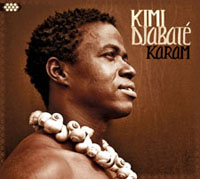
KIMI DIABATE
KARAM (Cumbancha CMB-CD12)
A sweet new disc from Guinea-Bissau is from the Cumbancha label, which promotes musical discoveries from all corners of the planet. The arrangements have horns, guitars and electric bass to fill out the traditional instruments: balafon, kora and West African percussion. Diabaté (who plays guitar, balafon and percussion) is a griot and his songs are steeped in the traditions of his native land. As a youth Kimi toured with the National Ensemble and settled in Lisbon, where he has collaborated with Mory Kante, Waldemar Bastos and others. He sings about poverty, freedom, women's rights and love; in short he is a modern griot. Nevertheless there is the strength of tradition to the album, albeit better recorded than efforts by the previous generation. This is most noticeable in the ballads. I have just read Mungo Park's journal of his travels in this part of the world. It starts slowly and gradually tightens its grip: it was certainly the worst possible journey in the world, and the amazing thing is when the naive Quixotic Mungo made it out in one piece, back to Guinea & the safety of a foreign ship, he got together a bigger expedition to go back! Talk about dogged determination. (This time he took 30 soldiers with him to their death!) This was two centuries ago: he was the first white man to try anything so foolhardy as a 500-mile trek to figure out which way the Niger flowed. He was robbed and imprisoned constantly and only escaped death by posing as a Moor, since the natives were in fear of the Arab horsemen who enslaved them. He mentions large groups of kora players preceding processions (coffles) and singing about their journey to gain admittance to villages on the way. Park would present the dooty or chief with $2 worth of amber beads (or more if they demanded it), and in return would get meat and milk. It's an amazing picture of a primitive life where the neighbouring villages were constantly at war and kidnapped each other to sell into slavery. It was not until modern times, the post-colonial era, that the West African countries settled into stability so their culture could blossom in tranquility, and Guineans who had Portuguese settlements in their midst and the usual addictions to foreign vice and luxury could overcome their dependence on outsiders. The Afro-Latin connection which flows back to much West African music is felt here in the lilting balafon, the horn arrangements and what we imagine are the purer strains of the kora melodies.

BA CISSOKO
SENO (Sterns STCD1108)
Ba Cissoko is a Guinean singer backed by a kora player. Another one? you ask incredulously, as if I were telling you about a new ex-Wenge Musica singer in baggy pants who parts his hair differently. But wait, there's more, he has a dubby band, fuzzy electric and flamencoid acoustic guitars, some cool conguero, bits of Latin and reggae, high production values. In short a fresh new take on the same old same old. It's unusual but pleasant to hear kora with some serious live dub going on, on "Bambo." Although Ba's name is on the masthead it's Sekou Kouyate who plays electric kora and did the arrangements. He also plays Tamani, which I think is a talking drum. Ba and Co are sons and nephews of kora master M'Bady Kouyaté and have brought a hip younger sensibility to the traditions of Conakry. In fact Ba is named after his grandpa Kimintan Kouyaté so the name of the band is shorthand for their continuing heritage. This is their third CD; 2007's Electric Griot Land showed the funk and Hendrix influences on such classics as "Allah Lake." Now they have got that out of the way there is some fine traditional-style acoustic playing here with the odd nudge in the direction of the future.
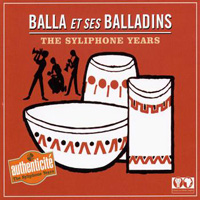
BALLA ET SES BALLADINS
THE SYLIPHONE YEARS (Sterns 3035-6)
This is one of the most-anticipated releases of the year, and I have to admit I was disappointed when I first put it on. In fact I was dumbfounded because it starts with most of the Jardin de Guinée album that came out on Syllart not so long ago. I began to think this was padding to make the set stretch to a double disc. And for a single dose of Les Balladins, nothing tops the Günter Gretz compilation in his African Dancefloor series (PAM ADC 302). "Sara 70" the gem of that set is repeated here. Indeed, four of the best tracks on here are also on REMINISCIN IN TEMPO, but you know everything these guys did is gold, so it's ultimately a real thrill to get hold of this box set, especially when you get to disc two. And here something has to be said in praise of the Syliphone engineer Moussa Konaté. So much African music of the 70s is murky, but the Syliphone studios sound clear as a bell. The compiler, Graeme Counsel sidestepped some heavily anthologized songs: "Samba," "Diaraby" and "Mana Mana," so there's more out there on other comps for new fans to discover. "Yo te contras Maria," the B side to "Diaraby" is included (the A side is on AUTHENTICITÉ, Counsel's previous Syliphone compilation album from Sterns, so not included here). "Yo te contras Maria" shows a return to Cuban music which President Touré originally wanted dropped from the bands' repertoires, but, as ties with Fidel strengthened, many of the Guinean bands got to tour to Cuba.
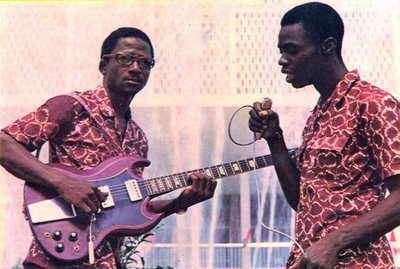
Sekou Diabate with singer Manfila "Soba" Kante
But Counsel could not avoid the previously anthologized "Kognö koura," nor indeed "Sara 70," one of the most gorgeous songs ever recorded, thanks largely to the spectacular guitar runs by Sekou "Docteur" Diabate on his Gibson SG. I have a post-it on my PAM disc, left-over from my DJ days, with the note "Dr Nico influence," as if I needed reminding. He even goes into "Merengue Nico" at one point. A surprise entry is a song called "Manta Lokoka" which is the name of a Brazzaville band who scored some hits in the 60s. It is played in the kiri kiri style of Nico. Great alto sax from Pivi and then Sekou Diabate kicks out the Brazzavillainous jams. It's my new favourite song by them. "Sakhodougou" and "Kaïra" (originally two side of a single) are old friends, with percussive guitar punctuated by horns, leading to a big swelling horn chorus played at third intervals. "Kaïra" means happiness. It was written in 1946 and became an anthem of the independence movements in west Africa in the 1960s. Manfila Soba Kanté's vocals blend with the crisply articulated guitar, the strident clarinet, the choral horns. "Ancient combatant," another single from the group, is equally wondrous: tightly arranged & delivered with an appropriate martial air, and some great use of Echoplex, but it seems to fade before it's over. The romping B side is included also.
Much of the Balladins' success lies in the instrumentation: both leaders, Balla and Pivi are horn players rather than guitarists or singers. Pivi plays a sexy trombone; Balla is a fiery trumpeter, and in addition they feature soprano, tenor, and alto sax, as well as clarinet and flute. There's even piano on one track ("Bedianamo"). They were both serious musicologists, deeply into folkloric research & were drafted into the Syli Orchestre National in January 1959. With the proclamation of an Authenticité movement at independence, Balla was sent to Italy to buy equipment for 60 bands! He and Pivi played at the Jardin de Guinée while a third member of the national orchestra played across town at the Bar de la Paillote. Eventually both bands became named for their leaders: Balla et ses Balladins, and Kélétigui et ses Tambourinis. At one point government interference transfered several band members to back Miriam Makeba and assigned a new singer to the band. Balla told the minister off and was demoted (they were government employees after all) so the band became Pivi et les Balladins. But at a concert at Le Palais du Peuple which was attended by the president, when they were introduced as Pivi et les Balladins, President Sékou Touré asked, "Since when?" and demanded Balla be put back in charge. Pivi and Balla remained partners & continued to make music into the 80s. After the death of Touré and a coup in 1984, funding for the arts was cut and the group disbanded. Many West African styles are represented in their music. There may even be country and western in there too, but when the guitar starts to wail I hear the muezzin. This is magical. There are people who would pay ANYTHING to get more of it, so perhaps the Complete Works is called for. A century from now, when we are over racist notions of primitivism, Balla, Pivi and Co will be seen as important to their time as Johann Strauss was to his 19th-century Viennese culture.
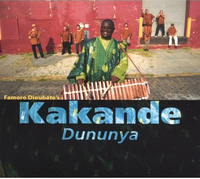
KAKANDE
DUNUNYA (Jumbie JMB0008)
Famoro Dioubate has been heralded throughout West Africa as one of the great Guinean balafon players. He grew up in a griot family and played with the National Instrumental Ensemble under his grandfather, legendary balafon-player Djeli Sory Kouyate. Now resident in New York, he has assembled a band of young Americans eager to learn from a master. The result is not quite as exciting as an album of genuine African music. The balafon is a continuo instrument. Sure Kélétigui or others have been know to rip out a striking solo, but basically it fills the role of the harpsichord in baroque music: it improvises on the changes and keeps everything moving along, allowing for the guitars (or violins) to be heard against a tapestry of modal harmonies. The guitar is played by Mamady Kouyate, otherwise there's a bunch of New Yorkers on flute, bass, cello and drums. They are competent but playing behind the balafon and augmenting it, rather than pushing into exploratory solos. After a fiery start, they settle into modesty. There's a reggae feel to "Souaresi" on the drums, but the vocals are wet & it almost grinds to a halt. Vocals are handled by another family member Missia Saran Dioubate and other Africans show up as guests on djembe and acoustic guitar. Things come back together for a great last track, "Temedi Kota," with buzzing percussion and a strident, demonstrative balafon solo. Overall, it's pleasant but doesn't move me.
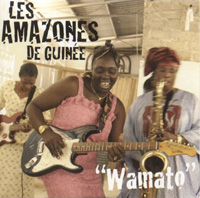
LES AMAZONES DE GUINEE
WAMATO (STERN'S STCD1106)
"Ah-ha! Le retour en force des Amazones de Guinée!" Thus begins this wonderful outing by the great all-woman band from Guinée's Military Police force, Les Amazones. The story of all-women groups is not particularly distinguished and mired in bands that are only fronted by women for the sake of merchandising. (There's the Bangles, the Donnas, Bananarama, the Dixie Chicks, the Gogos, the Shaggs, the Spice Girls, the Twelve Girls Band of China, the nazi teen twins of Prussian Blue, Puffy Ami Yumi among a host of J-Pop outfits, etc. Wikipedia lists dozens more but it makes sad reading & would make a worse playlist.) While it's novel, it's silly to celebrate Les Amazones as an all-woman band, but let's appreciate the fact that they are a long-established band and can still kick out the jams. This is only their second album: their first Au coeur de Paris (Bolibana, 1983) made it to my African TOP 50 with Balla & ses Balladins, Bembeya Jazz and Djeli Moussa Diawara. Pretty exclusive company. They were formed in 1961 as the Women's Orchestra of the Guinée Militia -- not a very inspiring name -- but as soon as they took the stage (out of their fatigues) they were called "goddesses" or "tigresses" and wowed audiences all across Africa. So a more glamorous name was called for. About 1985 they were supposed to tour the USA. I heard they were to play at Manyatta, a small Kenyan-owned nightclub in Oakland. I called the owner and confirmed. I hyped the show like crazy on the radio, playing the album all night, giving away tickets to ecstatic fans. But on the night the sad truth dawned, they weren't even in the country; it was all a dream. 25 years later they are better than ever. There's a great spontaneity to the playing. The rhythms chug, the horns accentuate, everyone knows their part so well. They are confident in call and response vocals, call and response guitar and horns. But it's more than military discipline, it's collective intuition from years of playing together. The chef d'orchestre is bass player Commander Salématou Diallo. She recruited some new members as the lead guitarist died four years ago and other members have retired after their years of military service. Lead singer M'mah Sylla and guest vocalist Aminata Kamissoko add a glossy sheen; Commandant Djenabou Bah and Mariama Camara give a whole new meaning to "military brass" while Capitaine Mato Camara on timbales, Capitaine Elisabeth Camara on congas and Mamade Cissé on drums keep a beat that is stirring rather than merely martial. Guest percussionist Adama Diarra throws in some blasting djembe and there's a couple of guest guitarists, including Sekou Kante who did the arrangements. Yaya Kouyaté on solo guitar and N'Sira Tounkara on rhythm outstrip their cohorts in the other national ensembles. The set is diverse, there's even a birthday song and they end with a sweet little salsa number.
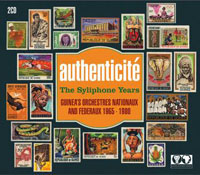
AUTHENTICITE
THE SYLIPHONE YEARS (Stern's STCD3025-26)
The LP era lasted fifty years (1948-98). It gave my generation a time-frame, 42 minutes, in which an artist would make a musical statement. Of course there were singles and then the 90-minute cassette, but we viewed them in the context of that 42 minute stretch. When it worked it was perfection. CDs were longer but inevitably slacker. Everyone agreed they were a poor substitute for LPs, but downloads are the nadir. There's nothing there but a sine wave (sounds like a bad cold), so while the record industry goes into meltdown, a generation grows up unaware of the tangible joy of the LP or the luxury of the gatefold album cover with 12-inch square ephemera included, a booklet bound in, or a crazy essay to read (without glasses) while listening to Coltrane or Frank Zappa. Now fans are falling back to the CD package as fungible for the LP experience, in a post-modern, bonsai-ed way.
Stern's has come up trumps with AUTHENTICITE a double-CD with a separate 44-page full-colour booklet that chronicles the great Guinean dance bands from 1965-80. The documentation is thorough, with great photos, album covers wonderfully reproduced (looking brand new in fact, thanks to Photoshop), and a snappy design that cleverly uses postage stamps to remind us of other obsessive compulsive collectors out there. (But, as I am fond of saying, just remember, philately will get you nowhere!) Once again Graeme Counsel, who did the classic Bembeya Jazz reissue in 2004, does the honours. The two discs are divided chronologically. The first is the less-familiar stuff and even includes unreleased material! We start off at a leisurely gait with Keletigui & his Tambourinis doing "Soundiata," a griot epic with a nice mix of horns, an asymmetric thud on the bass every now and then, and great solo guitar snaking through it. Balla & his Balladins follow up as we settle in for the ride. "Djanfamagni," a track from Bembeya Jazz (covering a well-known Manding song) cruises the "Peanut Vendor" changes. Continuing in a Latin vein, "Kankan-yarabi" by Orchestre de la Paillote has lovely vocals with trumpet and sax (Keletigui again) solos. Appropriately, for a song called "Information" by Kebendo Jazz we get some crucial information, for Counsel tells us on page 22 that, in addition to the 75 singles and 82 LP records that constitute the output of Syliphone, the radio station in Conakry has dozens of reel-to-reel masters of all the Guinean national and local bands performing. From the sound quality this is a remarkably intact archive, and there are more gems to be discovered. The first set ends with the magisterial Bembeya again doing "Boiro," with the perfect pairing of Demba Camara's vocals and Sekou Diabaté's guitar.
Despite too many praise songs for political organizations with initials for names, the first disc alone would be worth the price of admission, but there's more. It's safe to say you don't have any of the material on the first disc, but this compilation represents the cream of the whole range of official regional as well as unofficial local bands of Guinea, so there are some old favourites on the second disc, which covers the years 1972-80. After a storming "Kouma" by the 22 Novembre Band we get "Miri Magnin" by Keletigui (heard on the DISCOTHEQUE 73 CD), with long instrumental breaks featuring Keletigui, first on sax, then or organ. Pivi and the Balladins give us "Samba" (as heard on the DISCOTHEQUE 72 CD), one of my all-time fave ravers. Bembeya Jazz's "Bembeya" has been anthologized before, but this is an alternate take from a 45. The chorus is a little croaky, but the guitar is sublime. Horoya Band's rhythmically complex "Wèrè wèrè" was also on the DISCOTHEQUE 73 CD. There is a cover of it on Camayenne Sofa's LA PERCEE. Sombory Jazz's "Nana" is a gem that has not been anthologized before. Palm Jazz's "Zimaï" has a more Congolese feel to it and changes things up midway through the second set. Syli Authentique's moody "Fabara" appeared on the Syliphone 40th Anniversary album, volume 1, but fortunately there's not a lot of overlap with that other superb two-disc set. "Fabara," with its echoey guitar and big room boom, is haunting. Counsel tells us the band members were about 15 when it was recorded: they were considered traditionalists and were facing off nightly against all six of the national bands in Conakry, along with the Sofas and Kaloum Star (an excellent band, still extant I believe). "Karamoko" appears on Camayenne Sofa's ATTAQUE... disc. Again echoey guitar floats over cantering percussion. If you are lucky you have some of these vinyl LPs. There were a few mint copies of the Simandou de Beyla and Tropical Djoli Band albums circulating a few years ago and I grabbed them to add to my modest shelf of 18 Syliphone LPs. The Nimba Jazz track, "Ziko," is another overlooked classic. If you can stand this much good news, there are three other double CDs projected from this material, each devoted to a single band: Bembeya Jazz, Keletigui, Balla. It doesn't get better than that.
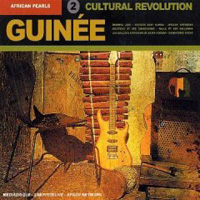
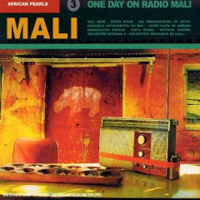
AFRICAN PEARLS vol 2: GUINÉE
CULTURAL REVOLUTION (Syllart)
This looks promising until you read the track list and realize it's Ibrahim Sylla up to his old tricks. It's a reissue of the Syliphone 40th Anniversary CD from circa 2000, and a few miscellaneous tracks from Bembeya Jazz and other bands that were in the Guinée Discothèque series. Now that I have established that, despite the similar name, Sylla is not connected to the Syliphone label I am less eager to give him my money and will save up for more of the original LPs. Sure it's great music but a pretty package doesn't make it sound any better. While there are two or three titles I don't immediately recognize who's to say they are not just songs with slightly revised names? "Kankan diarabi" could be one of three or four songs called "Diarabi" that are already on CD. "Abdree" must surely be "Andree" by Syli Authentique that is found on Discothèque 75. The typographical error approach to selling music does not guarantee return customers. There's a Mali volume, one from Congo and probably a Senegal in this series also. I checked the Mali playlist against my holdings and found it is a partial reissue of MUSIQUE DU MALI Sira Mori. This was one of two double-disc sets that came out a decade ago and are worth having in their full length. The other pair was called Banzoumana. Again I wonder about some of the titles. Now we find "Bakari Dian" by Super Biton de Segou. On Sira Mory it's "Bakary Jan" by Banzoumana Sissoko. It's great music if you don't already have it, but I will only be disappointed if I buy it for the four (of 20) titles I don't immediately find on my shelf to discover they were released under different names. Ultimately the reason I don't play these a lot is the sequencing. They lurch from folkloric to electric tracks back and forth so don't sustain a mood. Some of them are poorly mastered. I keep them because they have important historic tracks and every now and then if I am trying to find, say, an obscure Rail Band track it might be on one of these anthologies, so they were useful for me in my DJ days. Overall the Guinée set is more consistent and I would recommend it, if you don't have any Bembeya Jazz ("Petit Sekou" has been anthologized three times already), any of the Discothèque series, or the wonderful two volumes of Syliphone 40th Anniversary that contain over half of these tracks.
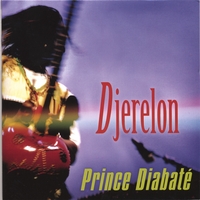
PRINCE DIABATE
DJERELON (All Music)
Prince Diabaté has taken a new direction on his latest album. He approached Kante Manfila to collaborate on the arrangements and production. Manfila decided that he would also like to play acoustic guitar on three of the songs. (Prince actually arranged the traditional Peulh song, FULBE FOUTA, on his own, despite the album credit) and, as noted, all the acoustic guitar work was done by various members of the Kante family, including cousin Mory Kante on solo guitar. This acoustic approach is a departure for Diabaté whose previous albums have been fused with funk, rap, reggae and other outside influnces. Here he has gone back to the Mandé roots of the Puehl or Fulani people of Guinée for inspiration. The title means "remember your roots" and the set proves that roots is best. The compositions are mainly the work of Diabaté, who plays kora, kamele ngoni & sings lead. There are also four traditional pieces. The ensemble is excellent and, though it's low key, it is a good mood album, perfect for a little mental safari to the bush of an evening. There's a one-string Fulani violin, Malinké and Fulani flutes and gongoman (which is the Susu thumb-piano), played by a wide array of talents, old and young, drawn from all corners of Guinée. Fode Sylla on djembe stands out, and Youssouf Conde on balafon acquits himself admirably. There are good harmony singers, meaning they are not shrill. All in all a pleasant hour of traditional music.
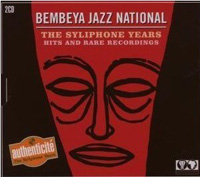
BEMBEYA JAZZ NATIONAL
THE SYLIPHONE YEARS: HITS AND RARE RECORDINGS (Sterns STCD3029-30)
I've already written a lot about this, one of my favourite African bands. Stern's has produced yet another handsome package and revisited their recent Bembeya on Syliphone double disc with remastered sound and an expanded selection. Two and a half hours of Syliphone music from the 60s and 70s is a mini-vacation from the real world: a mental spa. The 44-page booklet has been redesigned (up from 28 pages) and is much better, the pictures are big enough to see and the typography is legible. If you didn't buy the disc the first time, there is now an added track: "Guantanamera" which was previously only available as a download from the Stern's site. If you did buy it, give it to someone as a gift and buy this one too!
Bembeya Jazz is one of the top-rank African bands. From their founding in 1961 until today they have put out consistently great albums. In the 1960s and 70s they recorded for the Syliphone label in Conakry which has come to be recognized as one of the great treasure troves of popular African music. Graeme Counsel has put together a thoroughly documented and pretty much definitive double-disc of the band's greatest recordings. It must have been hard narrowing the choice down to 27 tracks but, even if you think you have them all, this album is a revelation.
In 2002, I was at a houseparty for Bembeya Jazz on their North American tour and the hostess introduced me to some of the younger band members as someone who knew more about their music than they did. Needless to say I was highly embarassed but I did get into a great conversation in French with several of the band members and found about their likes, influences and so on. I was humbled before these great musicians because I deeply love their music and had spent 25 years trying to find it. Now this music is getting the respect and attention it deserves. For a long time companies like Sonodisc tossed about the legacy of Africa (in their case the Congo) like it was brussels sprouts, but gradually new companies have come along, like Stern's, Soundways, Crammed Disc, Sharp Wood, PAM and Dakar Sound to name a few who are giving the music its due with intelligent liner notes, smart programming and handsome packaging. Bembeya is head of a long list of bands worthy of this treatment. True, when you have the magical sounds of Sekou Diabate on guitar you only need your imagination, but the presentation is an added thrill with artwork from obscure singles and EPs and band photos. Now you know how great the music is and will have to get this CD anyway. I am always first to say why buy it on CD when you have it on vinyl and in some cases on CD also?! Seven of the tracks appeared on "Hommage a Demba Camara," a fantastic compilation (see my TOP 50 AFRICAN ALBUMS) saluting the band's singer who died in a car accident at the height of their fame in 1973. The cream of that album is skimmed here.
Disc 1 has 14 tracks of which 10 have appeared on CD, four of them duplicated on 2 CD issues. However many of the Guinean Discotheque anthologies had a single Bembeya track strewn like stardust across a chill desert sky, and only a diehard would have made their own compilation to assemble the loose bits from their many singles and albums. The tracks stand out in the context of those albums, reminding us of the importance of the band, but their momentum is wasted. You really need to listen to an uninterrupted two and a half hours of Bembeya which is why you have to buy this compilation! You get an uninterrupted flow of musical magic that builds on each track and is pretty soon flying in the empyrean as Sekou weaves his web. Track 2 "Sabor de guajira" (which was the B side of their first single) shows them already masters of the Cuban charanga form as Sekou whips out a spectacular glittering lead. He pulls in behind the vocalist but sustains a bell-like pealing that echoes the clave, while the horns bleat like lost sheep. None of the renowned Senegalese bands ever approached a Cuban cover with as much success. This was due not so much to Bembeya's musical skill as to their understanding of tradition. Bembeya were pioneers in bridging the gap from the kora and balafon music of their parents to the burgeoning pop sensibilities of switched-on electric youth. There was no learning curve with this band: they came out running and already had a fully developed big sound anatomized into punchy horns and giddily spiraling guitar leads. Add the great percussion, vocals and chorus and you have an unbeatable formula. One of the new-to-CD tracks, a shameless plug for "Air Guinée" from their first LP, is quite funny with the band yelling out "Securite! comfort! vitesse!" before locking into a rocking E-minor A-minor jam. The next track also starts with a spoken part (perhaps they were listening to the funny intros to Congolese singles of the time.) "Super tentemba" (at 14 minutes the longest cut on here) was two sides of a single and shows them masters of the shifting terrain of a mental trip, like their neighbours the Rail Band, as they journey across the sonic landscape. It also sounds like a live recording, their spontaneity adding to the excitement as solo spots move around the band.
CD 2 has 12 tracks of which 11 have appeared on CD (three of them twice); only the first cut, "Beyla," is previously not collected on CD. It's from the rare LP "Guinée An X" (a reference to the tenth year of independence). The sound is a bit rough, leading me to wonder what shape the Syliphone archives are in. Remarkably many of Bembeya's best tunes were B sides to 45s (though wisely collected on albums and CDs later). The first disc includes 5 B sides, four of them better than their A sides! Graeme Counsel, who compiled this disc and wrote the excellent liner notes explaining each song, points out the traditional dance rhythm underlying one of their masterpieces "Moussogbe," from AUTHENTICITE 73 PARADE AFRICAINE (SLP39 on vinyl; 38221-2 on CD). The staggered rhythm sets the stage for Camara's vocals then Sekou comes skirling in with a distant Islamic plaint that seems to hover ghost-like over the whole tune. This is another one you wish would go beyond its 7 minutes. He keeps the sequence together so we get two more gems from the same album. "Sou," with its muted trumpet and smoky sax, is a morna Counsel informs us (the style recently popularized by Cesaria Evora). Here Sekou pushes the notion of "dry guitar" to a new height with a brittle plucking style (I think he must have draped his sleeve over the strings).
"Dya dya" is on my "secret Peanut Vendor" playlist: after collecting about 40 versions of "El Manicero" I started hearing it everywhere. There comes a point in every 1-4-5-4 jam where someone will quote either the cry of the peanut vendor ("Ma-neee!") or the actual riff ("Si tu quieres por el pi-co di'-ver-tir") that is the song's signature. Since "Mani" is just two notes I don't include those in the playlist, though I am tempted, but you'll be surprised how many songs use the turn-around (probably unconsciously) when jamming on those chords (G6, C and D7). The album ends with another favourite, "Petit Sékou," which makes me want to urge this album on you! Though I know these songs well, I have been playing this CD non-stop for a month (ignoring all the newer releases). It really gets under your skin!
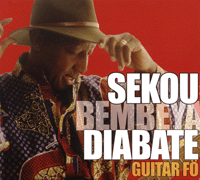
SEKOU BEMBEYA DIABATE
GUITAR FÖ (World Village)
Hot on the heels of last summer's succesful reunion with Bembeya Jazz, Sekou Diabaté, also known as "Diamond Fingers" has a new solo album out. Recorded between his European and American tours, it's basically Bembeya Jazz without horns and vocals, and since I was complaining bitterly about their trumpeter being flat, this is a bonus. Also the singing on here is not particularly good so the instrumental approach is welcome. Diabaté stands out, as always with his guitar pyrotechnics. I played it back to back with Mama Sissoko's solo album SOLEIL DE MINUIT and I have to say Sissoko (formerly guitar star of Super Biton de Segou) came out ahead. But while Diabaté has lost a touch of the speed and flash that made him so outstanding in the heyday of Bembeya Jazz (in the sixties and seventies), this is still an A-One album. For one thing it is better recorded than the old Bembeya albums. There are a few weak points: it's too long and drifts off into a noodly piece at the end that could have been omitted. The Duchess cracked up at the Hawaiian guitar because the singer sounds Hawaiian too and we imagined the grass skirts and undulating hand gestures that go with the sound. Sekou reprises a few Bembeya tunes again: "Ndianomo" from DIX ANS DE SUCCES, and his signature tune "Diamond Fingers" that is a cross between Franco's "Liwa ya wech" (slowed down) and Jeff Beck's speed workout "Beck's Bolero" -- an odd blend that curiously works well. The first track shows again his debt to African Fiesta as the mi-solo plays a classic Mwamba Déchaud progression giving him the centre stage for some Nico-esque pyromania. The instrumental approach makes this a great disc to play in the background while reading or cooking.
